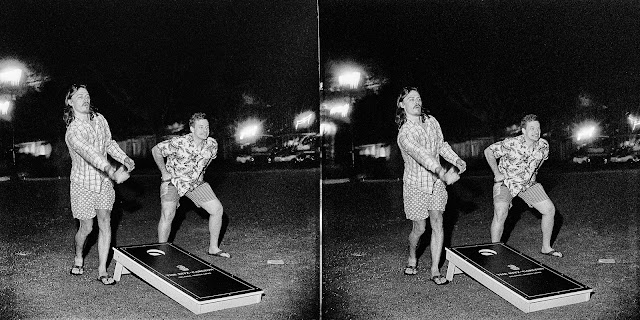Stereo (3-D) photography is pretty rad. Over the past few years I've taken to creating my own stereo cards and viewing them through stereoscopes that I've gathered at various antique malls and flea markets. While a bit of a lengthy process, I find making 3-D images to be worthwhile, as it's a unique and immersive way to look back on events. Lately, my go-to stereo camera has been the Revere Stereo 33, from 1953. Out of the handful of stereo cameras that I've used, I find the Revere to be the most precise, as well as the quickest to operate. I recently used the camera to document my brother's bachelor party weekend in Orlando, and got some great results! 
The Revere Stereo 33 takes 35mm film. Unlike some stereo cameras that I've used, the loading process is quick, and just as simple as with any normal 35mm camera. On a standard 24-exposure roll, you get about 16 stereo pairs (32 individual negatives). On my Orlando trip I got greedy, and tried to expose an extra few frames on one of my rolls. As a result I successfully ripped the film out of the cassette and had to take it it out of the camera back home in my darkroom (luckily it was the final roll of the trip). The frame counter does not reset automatically, and must be manually turned back to zero at the beginning of each roll. Oddly, the frame counter also doubles as the camera's rewind release. Once your roll is finished, you must turn the frame counter to "R," which disengages the advance sprocket and allows you to rewind the film. Weird!
Focusing is achieved via a knob on the top plate of the camera. Like many stereo cameras, the film plane moves instead of the lenses while focusing to keep everything in alignment. There are two windows on the back of the camera: one for focusing via a rangefinder patch, and one for composing the image. The focusing knob is positioned so it can be easily turned with your right thumb while your eye is to the rangefinder window. It can feel awkward at first, switching between the focusing and composing windows, but with some practice the process becomes second nature. If it's a bright day out you can shoot at f/16 and just scale focus (there's an awesome depth of field scale around the focusing knob).
 |
| The left window is for focusing, while the right is for composing |
The matched 35mm lenses provide a slightly wide field of view, and are pretty sharp! Apertures range from f/3.5 to f/22. Each lens has a leaf shutter, with speeds ranging from 1/2 to 1/200. 1/200 doesn't sound like much, but it's par for the course when it comes to stereo cameras. Most of the time you'll want as much depth of field as possible for your 3-D photos, so faster speeds aren't really necessary. Exposures with my particular camera aren't 100% matched (one negative always seems a little thinner than the other), but this is understandable for a 70-year-old camera, and it's easy enough to correct these slight differences in post. One extra feature that I love is the camera's ability to perform multiple exposures with a simple flick of a switch beneath the lenses. Multiple exposures in 3-D can look pretty trippy! Unfortunately, the Revere Stereo 33 does not have a standard hot shoe, nor does it have a sync port for attaching a flash. My workaround is with a Vivitar 283 flash, which sets its flash output automatically based on your camera's aperture setting. I match the output level on the flash with the aperture setting on the camera (usually f/16 so not too much ambient light gets in), start a bulb exposure, fire the flash manually using the test button on the back, then finish the bulb exposure. It's a pain for sure, but it works.
But yeah, overall I love the Revere Stereo 33. I've yet to find a 35mm stereo camera that is easier to use, or one that has more precise focusing. I plan on doing a lot more stereo work with this camera over the summer. Below are some stereo pairs that I made documenting my brother's big bachelor weekend. Unfortunately it's very difficult to see the 3-D effect without a viewer, but if you stare past the center of the pair, you can sometimes trick your eyes into seeing a 3-D image. It's also somewhat effective if you flip rapidly between the left and right eye images using a GIF, but in my experience, this doesn't work with every stereo image. The film was bulk-loaded Ilford HP5+.











